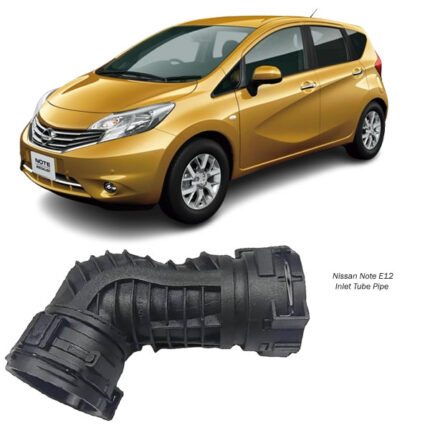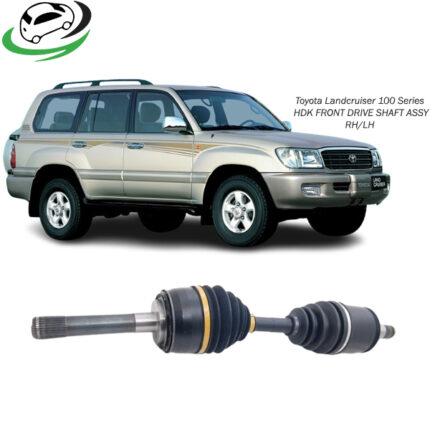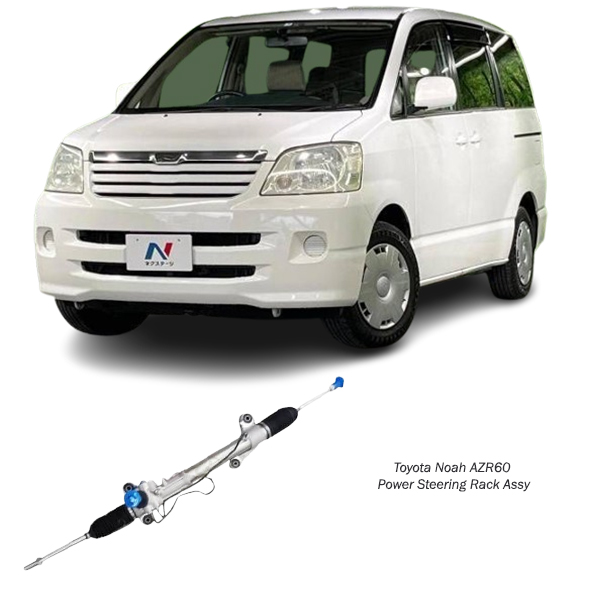-8%
Get Toyota Noah AZR60 Power Steering Rack Assy 44200-28510 in Kenya
The Power Steering Rack Assembly (often called a “power steering rack”) is a critical component in a vehicle’s power steering system, responsible for translating the driver’s steering inputs into wheel movements with the assistance of hydraulic or electric power. This mechanism enables smoother, easier steering and more responsive handling. Here’s an in-depth look at the power steering rack assembly, covering its structure, function, types, importance, signs of wear, causes of failure, and maintenance tips.
1. Overview and Structure of the Power Steering Rack Assembly
The power steering rack assembly is a specialized rack-and-pinion gear system that enables the steering wheel’s rotational motion to be converted into lateral movement, guiding the wheels. It consists of several main components:
- Rack Gear: A horizontal bar with gear teeth that engage with the pinion to enable left and right wheel movements.
- Pinion Gear: Attached to the steering shaft, the pinion engages with the rack gear, translating steering wheel movements into lateral motion of the rack.
- Hydraulic Pistons and Chambers: In hydraulic systems, pistons on either side of the rack provide assistance by using pressurized hydraulic fluid.
- Seals and Bearings: These maintain the assembly’s integrity and ensure smooth operation while keeping the hydraulic fluid contained.
- Tie Rods: Connected to the ends of the rack, tie rods link the rack to the wheels, transmitting movement to them for accurate turning.
Modern vehicles may use either hydraulic or electric power steering systems, and some may even have an electro-hydraulic setup that combines both methods.
2. Functions of the Power Steering Rack Assembly
The power steering rack assembly performs several essential functions:
- Assists with Steering: By reducing the physical effort required to turn the wheel, the power steering rack allows for smoother and more precise steering control.
- Converts Rotational Input to Lateral Movement: It converts the rotational input from the steering wheel into a lateral motion that guides the wheels in the desired direction.
- Improves Vehicle Stability: A well-functioning steering rack contributes to stability by ensuring that wheels respond predictably to driver input, which is especially useful during high-speed driving and tight turns.
- Enhances Driving Comfort: The power steering rack assembly absorbs and dampens shocks and road vibrations, making the driving experience smoother and more comfortable.
3. Types of Power Steering Rack Assemblies
There are several types of power steering rack assemblies, each with unique features:
- Hydraulic Power Steering (HPS): This type uses hydraulic pressure from the power steering pump to assist in steering. The hydraulic fluid is pressurized and sent to either side of a piston inside the rack to help turn the wheels. HPS is known for delivering smooth steering assistance but can add weight and require more maintenance.
- Electric Power Steering (EPS): In EPS systems, an electric motor attached to the steering rack provides the necessary assistance. EPS is lighter, more fuel-efficient, and easier to maintain than HPS. It also allows for variable steering response, adjusting assistance levels based on speed and driving conditions.
- Electro-Hydraulic Power Steering (EHPS): This hybrid system combines elements of both hydraulic and electric power steering, using an electrically driven hydraulic pump to assist with steering. EHPS is often found in larger vehicles and provides the power of hydraulic steering with the efficiency of electric systems.
4. Importance of the Power Steering Rack Assembly
The power steering rack assembly plays a critical role in a vehicle’s handling, performance, and safety:
- Safety: By enabling precise control over wheel movement, the power steering rack helps drivers navigate turns and maintain stability, contributing to safer driving conditions.
- Improved Handling: A well-maintained power steering rack allows for sharper handling, making it easier to control the vehicle, especially at higher speeds or on winding roads.
- Fuel Efficiency (in EPS systems): Electric power steering systems reduce engine load compared to hydraulic systems, improving fuel efficiency.
- Enhanced Comfort: With reduced steering effort, the driver can navigate the vehicle more easily, especially in tight spaces or during low-speed maneuvers like parking.
5. Signs of a Faulty Power Steering Rack Assembly
Detecting a failing power steering rack early can prevent further damage and enhance safety. Common symptoms of a faulty power steering rack include:
- Steering Wheel Stiffness: If turning the wheel becomes more difficult, this may indicate that the power steering rack is worn out or that there is a hydraulic fluid leak in the system.
- Unusual Noise When Turning: Knocking, clunking, or whining noises when turning the steering wheel can indicate wear in the gears or issues with the hydraulic pump or fluid.
- Steering Wheel Vibration or Play: Excessive play or looseness in the steering wheel may point to wear in the steering rack’s internal components, affecting vehicle handling.
- Fluid Leaks: If there’s a hydraulic fluid leak around the steering rack, it could mean that seals or hoses are damaged, reducing the system’s effectiveness.
- Vehicle Pulling to One Side: A malfunctioning steering rack may cause the vehicle to pull to one side, even when driving straight, which could lead to uneven tire wear and unsafe driving conditions.
6. Causes of Power Steering Rack Failure
Several factors can contribute to power steering rack failure, including:
- Wear and Tear: Over time, the steering rack components (especially the rack and pinion gears) can wear down, leading to performance issues.
- Contamination: Dirt, debris, and moisture can infiltrate the steering rack, damaging seals, gears, and bearings.
- Low or Contaminated Hydraulic Fluid: In hydraulic power steering systems, insufficient or contaminated fluid can cause friction, leading to accelerated wear or overheating.
- High Loads or Rough Driving Conditions: Driving on rough roads, hitting curbs, or carrying heavy loads can place undue stress on the power steering rack.
- Improper Installation or Alignment: An improperly installed power steering rack can misalign the wheels, causing increased wear on tires and suspension components.
7. Maintenance Tips for Power Steering Rack Assembly
Regular maintenance of the power steering rack can help extend its lifespan and maintain optimal performance:
- Check Fluid Levels Regularly (for HPS): For hydraulic systems, checking and topping up power steering fluid can help prevent wear. It’s also important to use the right type of fluid for your vehicle.
- Inspect for Leaks: Regularly inspect the steering rack and hoses for fluid leaks. Leaks indicate worn seals, which should be addressed quickly to avoid damage.
- Steering and Suspension Inspection: Routine checks of the entire steering and suspension system help catch issues early and ensure the rack is functioning optimally.
- Flush the Hydraulic Fluid Periodically: For HPS systems, flushing the hydraulic fluid every few years can help remove contaminants that may damage the system.
- Avoid Rough Driving: Minimizing rough driving and avoiding potholes can reduce wear and tear on the power steering rack.
- Replace Worn Tie Rods and Bushings: Over time, the tie rods and bushings that connect the rack to the wheels can wear out. Replacing them as needed will keep the rack in good condition and improve vehicle handling.
8. Replacement Considerations for Power Steering Rack Assembly
If a power steering rack shows signs of severe wear or failure, replacement is often necessary for safe driving. Here are some important considerations:
- Choose Quality Parts: Using OEM (original equipment manufacturer) parts or high-quality aftermarket components ensures compatibility and reliability.
- Professional Installation: Replacing a power steering rack can be complex, involving precise alignment and torque specifications, so professional installation is recommended.
- Inspect Related Components: When replacing the steering rack, inspect related parts like tie rods, bushings, and mounts. Replacing worn components at the same time can improve performance and prevent premature wear.
- Wheel Alignment After Replacement: Replacing the power steering rack may require a wheel alignment to ensure optimal handling and tire wear.
9. Cost and Long-Term Value of Replacement
The cost of replacing a power steering rack varies based on the vehicle’s make and model, labor costs, and the type of steering system. While replacement can be costly, maintaining a healthy power steering system enhances safety, reduces wear on related components, and improves driving comfort. For electric power steering systems, in particular, the reduced maintenance needs can offset the initial cost, making it a valuable long-term investment.
10. Conclusion
The power steering rack assembly is vital to a vehicle’s steering system, playing a crucial role in handling, safety, and driving comfort. By converting steering inputs into wheel movement with the aid of hydraulic or electric power, it allows for precise control and ease of maneuverability. Regular maintenance, attentive driving, and timely replacement are key to ensuring a power steering rack’s longevity, keeping the vehicle safe and comfortable for drivers and passengers alike.
Follow us on Facebook for more parts.



